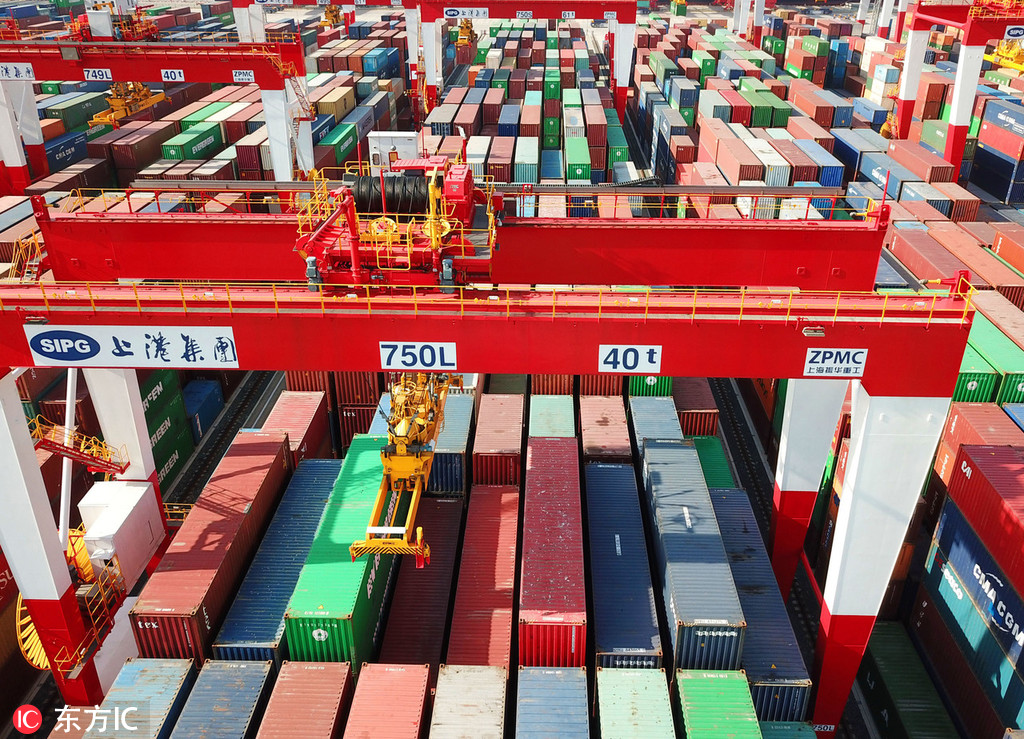New venture to enhance multimodal transport options at Shanghai Port


A joint venture focusing on multimodal transport is being established this month at the port of Shanghai, as part of efforts to increase transport efficiency and lower carbon emissions, according to a top company executive.
"Sea and rail transport should have played a greater role in container shipping. But it has grown slowly due to the insufficient railway network at Shanghai's major port area of Waigaoqiao and Yangshan. We expect to expand the ocean-rail transportation volume to 80,000 TEUs (twenty-foot equivalent unit) by the end of this year, and more than double this to 200,000 TEUs in 2020," said Yan Jun, president of Shanghai International Port Group (SIPG), a terminal operator.
SIPG will hold a 45-percent stake in the new joint venture, while China COSCO Shipping Corp Ltd will have 20 percent. The balance would be held by National Railway Administration and China Railway Container Transport Corp Ltd.
According to Yan, since last May, the company has been striving to increase the port's ocean-rail transport capacity, and currently all the foundation works have been completed. The multimodal transport company, with a heavy focus on technology, will have a competitive edge over road transport in environment and cost aspects.
"The absence of rail connection to major port areas has been a major barrier for the port of Shanghai. Railways are one of the most important solutions for logistics, and it is key to land transportation," said Lin Guolong, director of the Shanghai Maritime University's Logistics Research Center.
"Customers needing special requirements for timing and delivery will benefit from the service to be launched between Shanghai and Suzhou in Jiangsu province, Changzhou in Jiangsu province, Xuzhou in Jiangsu province, Chengdu in Sichuan province, Zhengzhou in Henan province and Xi'an of Shaanxi province," said Yan.
Railway transport trials are already under way since April as containers can be shipped directly via rail from Suzhou to Yangshan's Luchaogang hub (Pudong New Area) in three hours, according to Shanghai Shipping Exchange.
Compared to conventional transport, ocean-rail transportation can deliver goods at a fixed time with fixed amount, which ensures the punctuality of logistics with stable costs, according to experts.
Internationally, ocean-rail transport is a sophisticated transportation method with a history of more than 50 years. Under ocean-rail transport, imported or exported goods will be shipped via sea and rail without extra customs declarations. Sophisticated international ports usually have between 20 percent and 40 percent of their goods shipped by sea-rail transport. For transportation with distances of above 600 kilometers, water-rail can save about 30 percent costs than water-land, with additional environmental costs, according to the Economic Information Daily.
Merely 60,000 TEUs were transported by ocean-rail at the port of Shanghai in 2018, which is in stark contrast with the port's title of being the world's largest container port since 2010, and is far below its container operation volume of 42.01 million TEUs last year.
"The Shanghai port is closely following its goal of building a green port. In addition to increasing the ocean-rail capacity, it is also seeking to increase ocean-water transport weighing from 46.7 percent to 50 percent by the end of 2020," said Yan.
The Port of Shanghai has also announced plans to join hands with the Port of Ningbo-Zhoushan, the world's largest port by cargo turnover, for development, operation and management of the north side of Xiao Yangshan port area, which can significantly raise the efficiency of the whole Yangtze River cargo transit and lower costs at the same time, according to an agreement signed between Shanghai International Port Group and Zhejiang Seaport Investment and Operation Group earlier this year.
Public information showed up to 70 percent of Shanghai port's throughput comes from the Yangtze River Delta region, and nearly half of the products require additional transition by water.
Construction of the north side Xiao Yangshan development is expected to kick off by the end of 2019.
The first phase of the north side project will extend 1.2 km along the coast line, and have a total turnover capacity of 3.5 to 4 million TEUs, according to SIPG Chairman Chen Xuyuan.



































